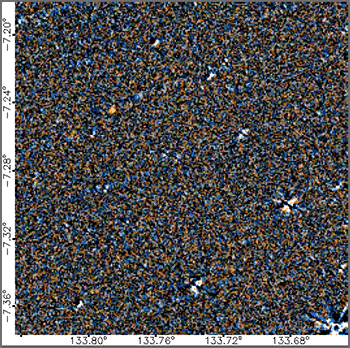Citizen science projects are a great way for anyone to be involved in the scientific process. Average, everyday folks have discovered things like supernovae, previously unseen craters on the Moon and Mars and even new planets orbiting a distant star.
Now, you could be part of one of the most exciting quests yet: finding a mysterious, unseen planet in te far reaches of our own solar system. Last year, Caltech astronomers Mike Brown and Konstantin Batygin found indirect evidence for the existence of a large planet, likely located out past Pluto, and since then, the search has been on. But so far, it has come up empty. And so, astronomers decided they would bring in a little help: You.
"Backyard Worlds: Planet 9 has the potential to unlock once-in-a-century discoveries, and it's exciting to think they could be spotted first by a citizen scientist," said UC Berkeley postdoctoral researcher Aaron Meisner, who is helping to head up this latest citizen science project.

A previously cataloged brown dwarf named WISE 0855?0714 shows up as a moving
orange dot (upper left) in this loop of WISE images spanning five years. By viewing
movies like this, anyone can help discover more brown dwarfs or even a 9th planet. Credit: NASA/WISE.
People who sign on to the Backyard World: Planet 9 website will be basically using the same type of technique that was used to find the last planet discovered in our solar system, Pluto. Clyde Tombaugh used a special machine that systematically switched images on glass astronomical plates back and forth, looking for any objects in the night sky that 'moved' between the images.
For Backyard Worlds: Planet 9, users will view brief "flipbook" movies made from images captured by NASA's Wide-field Infrared Survey Explorer (WISE) mission. A faint spot seen moving through background stars might be a new and distant planet in our solar system. Or it could be a nearby brown dwarf star, which would be another exciting discovery.
WISE's infrared images cover the entire sky about six times over. This has allowed astronomers to search the images for faint, glowing objects that change position over time, which means they are relatively close to Earth. Objects that produce their own faint infrared glow would have to be large, Neptune-size planets or brown dwarfs, which are slightly smaller than stars. WISE images have already turned up hundreds of previously unknown brown dwarfs, including the objects fairly close to us, so astronomers hope that the Backyard Worlds search will turn up a new nearest neighbor to our sun.
NASA wants to bring in all the humans it can for this search, because the human eye is much better than computers at seeing changes between images.
"Automated searches don't work well in some regions of the sky, like the plane of the Milky Way galaxy, because there are too many stars, which confuses the search algorithm," said Meisner.
"There are just over four light-years between Neptune, the farthest known planet in our solar system, and Proxima Centauri, the nearest star, and much of this vast territory is unexplored," said NASA astronomer Marc Kuchner, the lead researcher and an astrophysicist at NASA's Goddard Space Flight Center. "Because there's so little sunlight, even large objects in that region barely shine in visible light. But by looking in the infrared, WISE may have imaged objects we otherwise would have missed."
Check out Backyard Worlds: Planet 9 here, and give Universe Today the scoop when you make your big discovery!
You can find more info in the video below:
Source: UC Berkeley
No comments:
Post a Comment